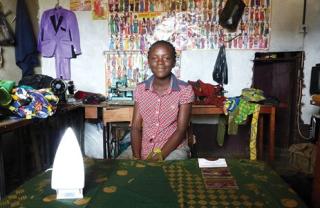Women and girls worldwide face significant challenges in accessing equal opportunities, particularly in STEM (science, technology, engineering and mathematics) and the energy sector. Despite progress, gender disparity persists, with women often underrepresented in technical roles and leadership positions. These are further exacerbated by sociocultural norms, biases and structural barriers – such as lower literacy rates and limited access to education and training.
These challenges, however, also present unique opportunities. Addressing the specific needs of women and girls through targeted interventions can significantly advance gender equity. Empowering women in sectors like energy not only contributes to gender equality but also enhances economic development, community resilience and overall sustainability.
Figure 1. A woman working as an apprentice in a tailor’s shop connected to the hydroelectric grid in Democratic Republic of Congo 1

Approaches to promoting gender equity
Promoting gender equity requires a multifaceted approach involving various stakeholders. For example, gender-responsive policy reforms are needed to encourage female participation in traditionally male-dominated sectors. This includes educational reforms, incentives for organizations to promote gender diversity and support for gender-focused initiatives. Such initiatives could include capacity-building – another critical component – providing targeted training for women and girls with a focus on technical skills and leadership development. Raising awareness of opportunities in the STEM and energy sectors can also demonstrate career pathways for women and girls, and forge a connection between education and the workplace.
Community leaders and stakeholders should also be fully engaged in advocating for and supporting women’s participation in non-traditional sectors. This often challenges cultural norms and biases that are limiting women’s opportunities. Additionally, it is crucial that project investment criteria prioritize gender-inclusivity and equality. In addition to setting targets or minimum thresholds for female employment and leadership, this approach can incentivize training and capacity-building beyond the project itself.
Incorporating the needs of women
Small hydropower (SHP) projects offer a compelling case study on how targeted interventions can promote gender equity. The hydropower sector is expected to employ 3.7 million people by 2050, emphasizing the potential for more gender-inclusive job opportunities2 SHP projects around the world have already been instrumental in challenging gender roles and creating opportunities for women in the energy sector, particularly in remote and rural areas. Nevertheless, women currently represent only 25% of the hydropower sector’s labour force, highlighting the need for more targeted interventions.
To overcome challenges, the report emphasizes the need for targeted actions by various stakeholders in the SHP sector 3:
- Policymakers: Develop gender-responsive policies and incentives to encourage women’s participation in STEM and SHP sectors. This includes reforms in education and support for organizations promoting gender diversity in their workforce.
- SHP Developers and Industry Leaders: Adopt gender-sensitive approaches in project planning and execution. This involves establishing training and mentorship programmes to empower women for higher-level positions in SHP, going beyond traditional roles.
- Investors: Reorient investment criteria to focus on SHP projects that demonstrate a commitment to gender equality, particularly in creating technical job opportunities for women.
- Community Leaders: Advocate for women’s active involvement in SHP projects, ensuring that their contributions are valued and their potential fully realized.
Positive outcomes and lessons learned
A recent report on the SHP sector confirms that SHP projects have significantly increased employment opportunities for women in various roles, ranging from technical positions to leadership roles. Examples from Zambia and China illustrate how SHP projects have transformed local job markets by providing diverse career paths for women. Training programmes have equipped women with essential technical and leadership skills, enabling them to take on higher-level positions and contribute meaningfully to the sector. By involving women in SHP projects, communities have benefited from increased productivity and economic development. Women's involvement has also promoted greater community resilience and sustainability.
However, the report also identifies several lessons learned. For example, overcoming sociocultural barriers is crucial but complex. It needs to begin at the grass-roots level, engaging community leaders and promoting gender-sensitive approaches to change perceptions and encourage a wider acceptance of women in technical roles. Capacity-building programmes must also be tailored to the specific needs of women, considering factors such as literacy rates and language barriers. Providing training in local languages and accommodating women's schedules can enhance participation and effectiveness. Moreover, SHP investments should be evaluated not only on technical and financial merits, but also on their social impact – particularly regarding gender equality. This holistic approach ensures that projects contribute to sustainable and equitable development.
Conclusion
SHP projects demonstrate how targeted interventions can advance gender equality while promoting sustainable energy development. By incorporating the needs of women into project design and execution, SHP projects have created significant opportunities for women in the energy sector. The positive outcomes and lessons learned from these initiatives provide valuable insights for future efforts to promote gender equity across various sectors. As the world continues to address the challenges of climate change and social inequality, integrating gender-focused strategies into sustainable development projects offers a pathway towards a more inclusive and equitable future.
Disclaimer: The views expressed in this article are those of the authors based on their experience and on prior research and do not necessarily reflect the views of UNIDO (read more).
Have your say
What is your opinion on the IAP?



